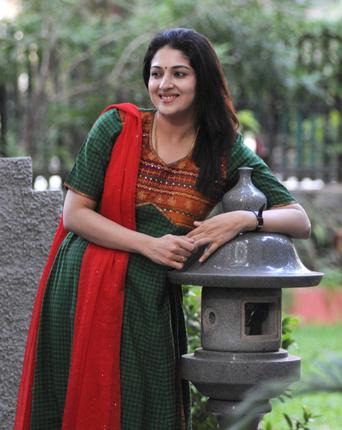
Srinidhi Chidambaram’s individuality shines as she pushes the boundaries of the Margam.
At a time when small children spent hours at home playing, Srinidhi Chidambaram straddled the stage to playact the role of young Bharata (as a four-year old) in the production, ‘Shakuntalam,’ led by legendary dancing queen Kumari Kamala. Young Srinidhi put to rest the fears of her grandmother that she would fall asleep even before her curtain call… For, not only did she stay awake, but she also got her dialogue delivery right! She, thus, stole the hearts of the viewers, and from then on, there has been no looking back.
For almost seven years, from the age of three, Srinidhi trained under Guru Kamala. Recollecting the time spent with her teacher with fondness, Srinidhi remembers the unconventional approach she had to teaching, making the learning process enjoyable even as they played – at the same time, she was a disciplinarian and a perfectionist, and there were no short-cuts.
Yet one lesson remained imprinted in Srinidhi’s mind, a lesson she continues to pay heed to even today- Kamala taught her that dancers were never to show their disapproval of accompanying artists, by ‘stomping their feet’ or ‘glaring at them’, if a faux pas had taken place during a concert, and ‘never to pick up fallen jewellery’ while still on stage.
Completing her arangetram at the age of seven, she began giving solo performances and suddenly two years later, she found herself without a guru when Kamala decided to migrate to the U.S. It was then that the search for her next guru led her to the great teacher, Swamimalai S.K. Rajaratnam Pillai, who moulded and chiselled her talent.
The strength in precise geometric lines combined with grace seen in her dance was her guru’scontribution. The musical and choreographic genius that he was, he ensured that each of his students developed their individual identity, without becoming clones!
He also encouraged his students to choreograph the songs independently. This, she says, “helps me to create new choreographies even to this day. The additional training I received in music, under Suguna Purushottaman and Kamalarani for nattuvangam, has also added depth to my work.’’

Child prodigy
This dancer who was labelled ‘child prodigy’ by the famous critic Subbudu, went from strength to strength, carving a niche for herself. A classicist in her own right, she has been acknowledged for her excellence in dancing to the traditional Margam repertoire. With experience and maturity came the urge to be creative, which found her pushing the boundaries of the Margam, without moving away from it. The recent years have seen her perform to the new repertoire that she is slowly working on. ‘Chennai’ was her response to the city that has been so much a part of her growing up, and as a Chennai girl, she did a full length Margam as a tribute to the city she loves.
In this search for new themes rose the need for new compositions, and this time it was her father-in-law who introduced her to the poetic world of Vairamuthu, which she absorbed so easily, especially since she was inculcated into the love for Tamizh literature by her teacher at Good Shepherd Convent, Shanti Ganesan. “Vairamuthu’s poetry,” she says “has the ability to convey the deepest emotions in simple, but attractive Tamizh that goes straight to the heart, and has a cadence that lends itself well to music.”
Srinidhi has choreographed many pieces based on his poems and memorable is her response to ‘Avasara Thalatu,’ the woes of a working mother of today, who dons several hats even as she tries to juggle her time between her career and home. In today’s fast paced world, where mothers seldom have the luxury of a slow paced thalattu or lullaby, ‘Avasara Thalatu’ comes as perhaps the best answer! When Nature exploded with rage in Uttarakand, the artist in her sought Vairamuthu once again, this time to unleash her queries about Nature’s Fury.
The immense support that she has received from her long time associates, Swamimalai Suresh and Radha Badri, has given her the much needed strength to add a new dimension to the classical Thanjavur Quartette piece, ‘Sakhiye inda velayil.’ She modestly admits: “One cannot perhaps beautify a composition that is already so brilliant. Yet I have attempted to do so.” To the lines of the pallavi, anupallavi and charanam, she has incorporated some verses from Divya Prabandam and Nachiar Thirumozhi, which are appropriate and blend well with the ideas expressed in the varnam.
When asked about the response to her innovation, she said candidly that it was a “mixed bag” – “I take criticism in my stride and my worst critic is my mother!”
She continues to explore further and has recently worked on a medley of Tyagaraja kritis, as a composition on the lines of a varnam besides experimentation with the thillana too. She is quite excited about this new phase of a creative journey.
Managing a full time career as a medical professional, it is her deep love and passion for the arts inculcated in her by her grandmother and parents that see her sailing from one Season into another.
For Srinidhi, it has certainly been a long and fruitful journey dotted with many awards and accolades, the most notable being the Kalaimamani and the Nrityachoodamani.
source: http://www.thehindu.com / The Hindu / Home> Features> Friday Reviw> Dance / by V. V. Ramani / Chennai – February 27th, 2014